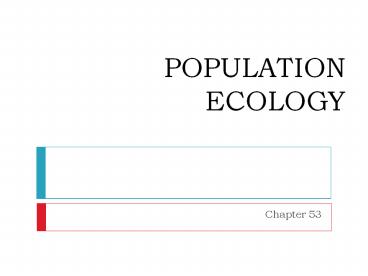POPULATION ECOLOGY - PowerPoint PPT Presentation
1 / 29
Title:
POPULATION ECOLOGY
Description:
POPULATION ECOLOGY Chapter 53 Density and Dispersion What is the density of a population? The number of individuals per unit area What are the three patterns of ... – PowerPoint PPT presentation
Number of Views:231
Avg rating:3.0/5.0
Title: POPULATION ECOLOGY
1
POPULATION ECOLOGY
- Chapter 53
2
Density and Dispersion
- What is the density of a population?
- The number of individuals per unit area
- What are the three patterns of dispersion?
3
Clumped
- Clumped dispersion has population occurring in
patches - Increased concentration of resources leads to
clumping - Defense against predators
- e.g. schools of fish, sea stars grouping together
where food is abundant
4
Uniform
- Even spacing of individuals within the population
- Diminishes competition
- Often seen with plants, they secrete chemicals
that prevent germination and growth of
individuals that may compete for resources. - King penguins exhibit uniform spacing due to
aggressive interactions between neighbors
5
Random
- Spacing is varied and unpredictable
- Occurs in the absence of strong attraction
(concentrated resources) or strong repulsion
(avoidance of competition) between individuals. - Dandelions grow where seeds randomly land
6
Estimating Population Size
- Mark re-capture method.
- You capture 200 grasshoppers, mark them all and
then release them back into the wild. A few days
later you capture 100 grasshoppers and 50 of them
were marked. How many grasshoppers do you
estimate are in this population? - N marked x total captured second time
- number marked recaptures
- 200 x 100/50 400
7
Demography
- What is demography?
- Study of vital statistics that affects population
size
8
Survivorship Curves
- What is a survivorship curve?
- Plot of the numbers of a cohort that are alive at
each age. - Survivorship curves are generally classified into
three types
9
(No Transcript)
10
Characteristics of The Three Types Seen in
Survivorship Curves
- Type I Low death rate in early years.
- Small clutch sizes and good care for young
- Type II constant mortality throughout life
- Type III large clutch size, little care for
young high mortality rate early on in life.
11
Life Histories
- What is the life history of an organism?
- Traits that affect time of reproduction and
death. - 1. Clutch size
- 2. Number of reproductive episodes per
lifetime - 3. Age at first reproduction
12
(No Transcript)
13
Birds with high probability of dying have larger
clutch sizes
14
- Number of reproductive episodes
- Large clutch sizes mean one reproductive episode
per life. - Small clutch sizes means more than one
reproductive episode - Age at first reproduction is younger in large
clutch size reproducers, they invest less energy
in their own growth and development.
15
Exponential Growth
- J shaped curve
- Unlimited population growth, due to unlimited
resources. - r selected populations favor the exponential
growth curve. Seen in areas with little
competition - Opportunistic species display this pattern,
grasses, insects - But all populations eventually have a limit
placed on their growth...
16
Logistic Growth
- Limiting factors will affect the size of a
population - K carrying capacity, never changes
17
Examples of logistic growth
K selected species - likely to be living at
carrying capacity, seen in areas with competition
18
- r selected
- short maturation time
- short life-span
- high death rate
- many offspring/reproduction
- one reproductive event
- reproduces early in life
- small size to offspring
- no parental care
- K selected
- long maturation time
- long lifespan
- low death rate
- few offspring/reproduction
- several reproductive episodes
- reproduces later in life
- large sized offspring
- parental care for young
19
Population Limiting Factors
- Density dependent factors
- Intensifies as population grows
- Density independent factors
- Affects same number of individuals regardless of
population size. - A predator is which sort of limiting factor?
- Density dependent
- A hurricane is which sort of limiting factor?
- Density independent
20
What sort of limiting factor is seen here?
21
Density dependent!
22
What sort of limiting factor is seen here?
23
Density independent
24
Usually more than 1 limiting factor is at work
25
- Fluctuations in sheep population due to weather
- Cold, wet winters weakens sheep and decreases
food availability leading to a decrease in the
size of the population
26
- Moose population collapse coincided with a peak
in the wolf population from 1975-1980 - Second moose population collapse in 1995
coincided with harsh winter weather which
increased the energy needs of the animals and
made it harder for the moose to find food
27
- Describe the population shifts of snowshoe hare
and lynx
28
Human Population
- Global population is still growing but the rate
of growth is slowing down - Age structures - relative numbers of individuals
at each age. Used to tell if a population is
increasing, decreasing or staying the same - birthrate, death rate, generation time and sex
ratios, all affect interpretation of age
structures
29
(No Transcript)































